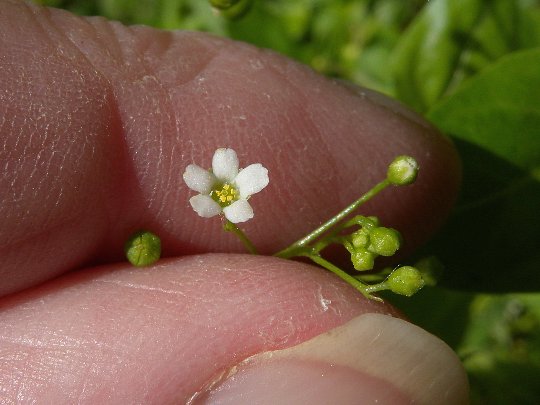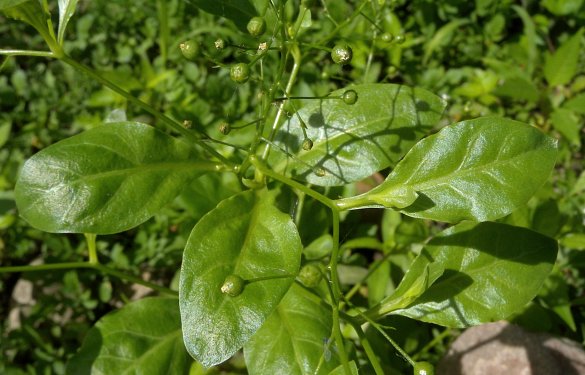Description: This perennial plant is about ½–1½' tall and erect to sprawling. Smaller plants are unbranched, while larger plants branch occasionally. There is a small tuft of basal leaves, from which a central stem with alternate leaves develops. The central stem and any lateral stems are green, terete, and glabrous. The leaves are up to 3" long and 1" across, becoming smaller as they ascend the stems. The leaves are green, ovate to obovate, glabrous, and smooth along their margins. The leaves taper to slightly winged petioles up to ½" long. Each upper stem terminates in 1 or 2 racemes of flowers. The central stalk of each raceme is straight to slightly zigzag and up to 6" long; it is green, slender, terete, and glabrous. The widely spreading to ascending pedicels are about ½" long; they are green, slender, terete, and glabrous. Each pedicel often has a single scale-like bract near its middle that is about 1 mm. in length. Each flower is about 1/8" (3 mm.) across, consisting of a short corolla with 5 white petaloid lobes, an open-globoid calyx with 5 small teeth along its upper rim, 5 stamens with yellow anthers, and an inferior ovary with a short style. The calyx is green, glabrous, and persistent. The flowers begin to bloom from the bottom to the top of the raceme. The blooming period occurs from early summer to early fall, lasting about for 2-3 months. Afterwards, each flower is replaced by an open-globoid seed capsule about 1/8" (3 mm.) long with 5 small teeth along its upper rim. This capsule contains many small seeds; it is initially green, later turning brown at maturity. The root system consists of a tuft of shallow fibrous roots. This plant spreads by reseeding itself.

Cultivation:
The
preference is light shade to full sun, wet conditions, and mucky or
rocky soil. This plant can grow in shallow water and withstands
occasional flooding.
Range & Habitat:
The native Brookweed occurs occasionally in most areas of Illinois,
except the NW section of the state, where it is rare or absent (see Distribution
Map). Habitats include swamps, low rocky areas along rivers,
borders of small streams in
wooded areas, borders of vernal pools, and soggy areas of floodplain
woodlands.
Brookweed occurs primarily in both degraded and higher quality
wetlands, usually in areas where there is partial shade.
Faunal Associations:
There is very little information about floral-faunal relations for this
species. Robertson (1928) observed a single Dance Fly, Empis
clausa, visiting the flowers for nectar. White-Tailed Deer
have been observed eating the foliage.

Photographic
Location:
Along a river in Vermilion County, Illinois.
Comments:
Because the flowers are small and the foliage blends into the
background, Brookweed is easy to overlook. Generally, this plant is
found in inaccessible soggy places, except during periods of drought
when the water level of its wetland habitats recede. Brookweed
doesn't closely resemble any other
floral species in Illinois, and it is the sole species of its genus
within the state. There is some resemblance
to chickweeds (Stellaria
spp.), but Brookweed has
alternate leaves, while chickweeds have opposite leaves.
Distinctive characteristics of Brookweed include its
open-globoid calyces, open racemes of flowers, and glabrous
foliage. Scientific synonyms of this species include Samolus
valerandii parviflorus and Samolus floribundus.
Another common name for this species is Water Pimpernel.